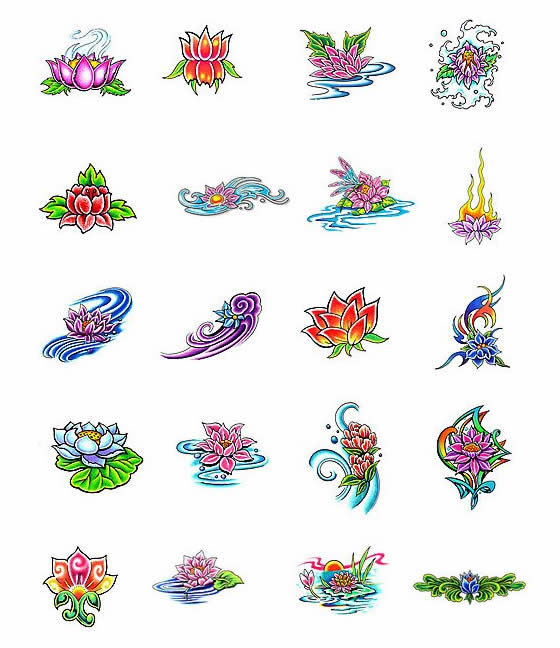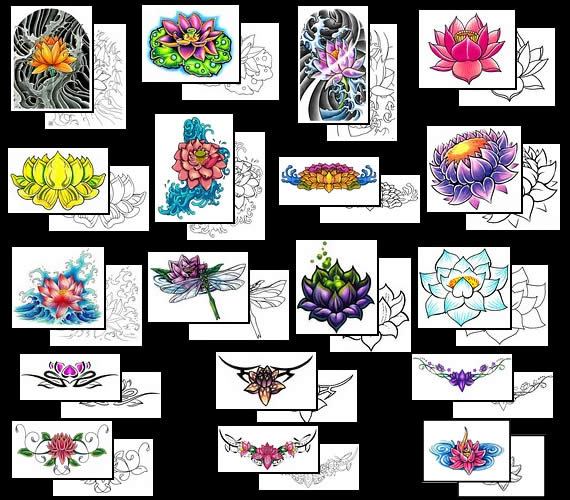|
|
|||
 |
|||
|
TATTOO DESIGNS & SYMBOLS - LOTUS FLOWER TATTOOS
Tattoo Symbol Index - A B C D E F G H I J K L M N O P Q R S T U V W X Y Z Tattoo designs - L >> Lotus flowers
In India, the "thousand-petaled lotus" (padma) was visualized as the mouth or doorway of the universe, so it's not surprising that it was thought of as the idealized vulva through which all life was delivered. And no surprise that all the primary deities in the Hindu pantheon are depicted with the lotus. Some sit at its centre, some stand or recline, and they're usually shown holding another lotus. Lord Vishnu, one of the three gods of the Hindu triad (trimurti), is described as having the lotus springing from his navel, from which Brahma was born. Lord Krishna was called the "lotus-eyed one", a reference to his divine beauty. The perfection of the lotus bloom has inspired humans to the highest aspirations. Seeing the lotus blossom "floating" on the water, its petals opening to the sun - this has long been the perfect analogy of the human soul opening to the light of the divine. That is springs from the mud seems like a miracle, all the more so because its petals appear free of any dirt or slime.
In Tantra and Yoga philosophy, the body's seven energy centres (or "chakras") are crowned at the top of the skull by the "thousand-petaled lotus" which symbolizes the attainment of enlightenment. In both the Hindu and Buddhist religions, the lotus is the symbol of freedom from attachment. This refers again to the lotus being in perfect relationship with its surroundings - totally within the world without being mired or touched by it. In a word, "harmony". Hindu scriptures describe the "lotus in the heart", the resting place of Atman, the soul. From this centre, like the petals of the lotus opening to the light of the sun, beams the light of the soul.
The lotus in its bud form was the symbol of the upper Kingdom of Egypt. Lotus wreaths were used in funerary ritual as rebirth symbols. In temples and on tombs, the gods and royalty were depicted holding the lotus in their hands. In many Eastern religions, the lotus carries the same significance as the rose does in Christianity. Just as the "Rose of Sharon" - a flower that blooms in the desert - is the symbol of Christ, the lotus likewise emerges from the mud as the symbol of the Buddha in many parts of Asia.
The Indian colour code prescribes white lotuses for purity, blue for goodness, and red for enlightenment.
Some art historians theorize that every decorative device - from Persian rug designs to Islamic architecture - can be traced to the lotus, more particularly the lily of the Nile. With its associations of regeneration and immortality, combined with the design's mobility as a carpet motif, the lotus impressed itself upon every country in the Orient. The contemporary Lotus Temple of the Bahai faith in Kalkaji, in south Delhi, is a sign of the lotus' ongoing popularity as a symbol. The temple takes the shape of a half-opened lotus flower, attracting people of all races and cultures. The architectural statement supports the Bahai position as "an independent religion, divine in origin, all-embracing in scope, broad in its outlook, scientific in its scope, humanitarian in its principles, and dynamic in its influence".
Get inspired by some really amazing images and photos in our Lotus Flower Inspiration Gallery See also Flowers, Buddha, Religious Tattoo Index, Japanese Tattoo Index, Buddhist Tattoo Index, Flower & Plant Tattoo Index
Choose your own lotus flower tattoo design from Tattoo-Art.com.
Choose your lotus flower tattoo design from the world's top tattoo artists and illustrators at TattooJohnny.com. Buy your own lotus flower tattoo design today. Tattoo designs - L >> Lotus flowers Tattoo Symbol Index - A B C D E F G H I J K L M N O P Q R S T U V W X Y Z |
||
| Celeb Tattoos | Facts & Stats | Designs & Symbols | History | Culture | Links | Tattoo Galleries | Contact | |||
|
|
|||



 Lotus
Flower/Water Lily Tattoo Design Meanings -God's favourite flower the lotus has earned such a reputation by
appearing front and centre in religious myths around the world.
Considered to be perfection in form, the lotus has been associated
with many creation myths. With its radiating petals, the lotus
connotes the "divine vulva" that gave birth to the gods and
goddesses of ancient religions. These deities are often depicted in
the company of this pristine flower. It became a sacred symbol for
all that is beautiful on earth, and a reflection of divinity, purity
and eternity.
Lotus
Flower/Water Lily Tattoo Design Meanings -God's favourite flower the lotus has earned such a reputation by
appearing front and centre in religious myths around the world.
Considered to be perfection in form, the lotus has been associated
with many creation myths. With its radiating petals, the lotus
connotes the "divine vulva" that gave birth to the gods and
goddesses of ancient religions. These deities are often depicted in
the company of this pristine flower. It became a sacred symbol for
all that is beautiful on earth, and a reflection of divinity, purity
and eternity. 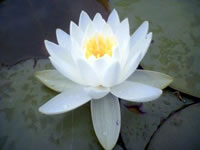
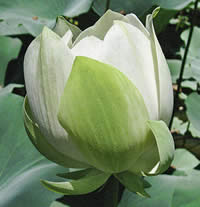 In its bud form, it is seen as the folded heart with the potential to open up and attain divine realization through spiritual practice and commitment. The folded lotus is therefore a symbol of the greatest human achievement - the journey from ignorance to enlightenment - and suggests that it is a natural consequence of human existence.
In its bud form, it is seen as the folded heart with the potential to open up and attain divine realization through spiritual practice and commitment. The folded lotus is therefore a symbol of the greatest human achievement - the journey from ignorance to enlightenment - and suggests that it is a natural consequence of human existence. 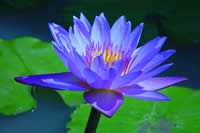 For ancient Egyptians, the lotus was a solar symbol. The spread and span of its petals were the sun's rays, the giver of light and life. With each dawn, the petals opened, closed at night and opened again with the rising sun, representing rebirth and renewal. The blue lotus (also known as the blue lily of the Nile) was considered the most sacred. It was the symbol of modesty and cleanliness. The seeds of the lotus can remain dormant in dry riverbeds for 200 years waiting for the rains, at which time the blossoms emerge from the mud radiant and unsullied. The lotus was regarded by early Egyptians as symbols of resurrection and life eternal.
For ancient Egyptians, the lotus was a solar symbol. The spread and span of its petals were the sun's rays, the giver of light and life. With each dawn, the petals opened, closed at night and opened again with the rising sun, representing rebirth and renewal. The blue lotus (also known as the blue lily of the Nile) was considered the most sacred. It was the symbol of modesty and cleanliness. The seeds of the lotus can remain dormant in dry riverbeds for 200 years waiting for the rains, at which time the blossoms emerge from the mud radiant and unsullied. The lotus was regarded by early Egyptians as symbols of resurrection and life eternal. 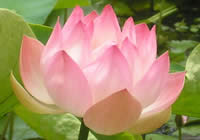 The "throne of Buddha" - that's how Buddhists see the lotus. The eight petals of the lotus represent the eightfold path of Buddhist law called dharma. We find the lotus at the heart of the Buddhist mandala (a design representing cosmic order), symbolizing the embryo of the world. Coloured lotuses represent various aspects of human attainment white signifying mental purity, red for compassion and the heart, blue for intelligence and wisdom, and purple for mystic insights. The pink lotus is reserved as the symbol of the historical Buddha.
The "throne of Buddha" - that's how Buddhists see the lotus. The eight petals of the lotus represent the eightfold path of Buddhist law called dharma. We find the lotus at the heart of the Buddhist mandala (a design representing cosmic order), symbolizing the embryo of the world. Coloured lotuses represent various aspects of human attainment white signifying mental purity, red for compassion and the heart, blue for intelligence and wisdom, and purple for mystic insights. The pink lotus is reserved as the symbol of the historical Buddha. 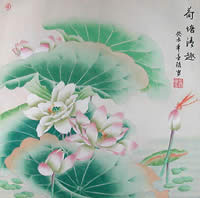 In China, the lotus has likewise been a religious symbol and inspiration for poets and artists. Merely gazing at a painting of a lotus was believed to draw one into the heart of perfection. Sufficiently inspired, the viewer would then seek their own inner potential. The long fibrous stem of the lotus is not easily broken, a quality that the Chinese adopted as a symbol of marital fidelity and harmony. The lotus was also associated with feminine beauty. The flower emerging from the pond was "like a very beautiful woman coming gracefully from her bath". The lotus was also likened to "gentle people who keep themselves clean". Ancient Egyptians said something similar about the sacred blue lotus, since dirt doesn't adhere to the leaf or blossom.
In China, the lotus has likewise been a religious symbol and inspiration for poets and artists. Merely gazing at a painting of a lotus was believed to draw one into the heart of perfection. Sufficiently inspired, the viewer would then seek their own inner potential. The long fibrous stem of the lotus is not easily broken, a quality that the Chinese adopted as a symbol of marital fidelity and harmony. The lotus was also associated with feminine beauty. The flower emerging from the pond was "like a very beautiful woman coming gracefully from her bath". The lotus was also likened to "gentle people who keep themselves clean". Ancient Egyptians said something similar about the sacred blue lotus, since dirt doesn't adhere to the leaf or blossom. 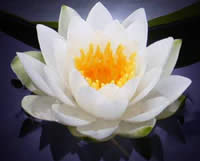 Lotuses (and water lilies) are often depicted in traditional Japanese woodblock prints, a motif that has heavily influenced traditional Japanese tattoo artists.
Lotuses (and water lilies) are often depicted in traditional Japanese woodblock prints, a motif that has heavily influenced traditional Japanese tattoo artists. 
